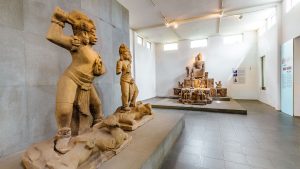When you arrive in the central strip of Vietnam, it is highly recommended that you spend some time visiting the remnants of Champa culture. You will be able to see these landmarks which tell the story of a kingdom that has lived throughout the history with your own eyes.
History of the Champa culture
The origin of Champa culture
From the 2nd century AD, the central region today is the land of many emirates including Lam Ap – Champa (present-day North Central region). The birth of the empire is considered the process of convergence and development of the prehistoric culture of Vietnam, specifically the Sa Huynh culture.
The coastal provinces along the central region from Quang Binh to Binh Thuan and the Western Highlands provinces were once part of the territory of the ancient Champa kingdom, from the end of the 1st century, early 2nd century to the end of 13th century, early 14th century. This kingdom had created a rich and sophisticated cultural heritage.
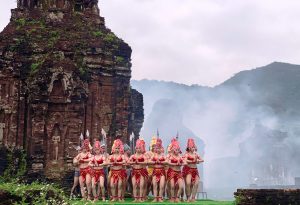
Characteristics of Champa culture
It can be said that the massive Cham towers with unique architecture and skillful construction techniques are the characteristics of Cham culture. Those towers are usually built of red-pink or dark-red bricks, spreading wide and tapering at the top in the shape of a flower. Most of the towers are in the shape of a quadrangle, the interior space is tight and the doors are often open to the east – the direction of the rising sun. The top of the tower is gradually reduced or leveled, in the heart of the tower lies a stone altar. Most especially, the art of carving on Cham towers is always extremely sophisticated and impressive.
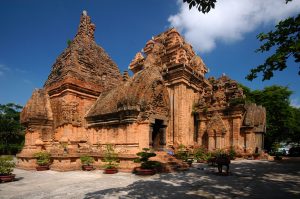
Champa cultural relics spreading along the central region
Quang Binh, Quang Tri, Thua Thien Hue
Quang Binh, Quang Tri, Thua Thien Hue are located in the north of Hai Van Pass, which is the northernmost region of the ancient Champa kingdom.
Throughout 12 centuries, the tower was buried in sand, Phu Dien Cham tower (or My Khanh tower) was accidentally discovered in 2001 in My Khanh village, Phu Dien commune, Phu Vang district, Thua Thien Hue province. Current studies specified that the tower dated back to the 8th century – one of the oldest remaining Cham towers along central Vietnam.
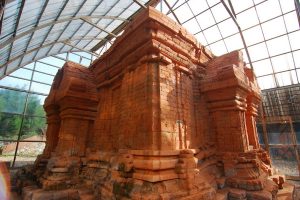
Although there are not many temples and towers standing firmly on the ground, the northern Champa area has many traces of foundations, sculptural artifacts and some epitaphs. These epitaphs dated back to the 6th to the 20th century, recording the construction of Siva temples and Buddhist buildings.
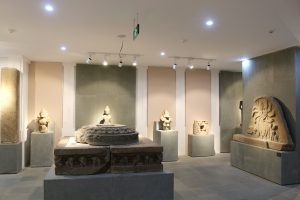
Quang Nam
My Son Sanctuary is a famous Cham cultural relic in Duy Tan Commune, Duy Xuyen District, Quang Nam Province. The Sanctuary was discovered in 1885 and recognized by UNESCO as a World Heritage Site in 1999.
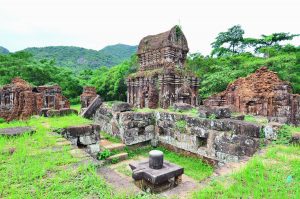
There are more than 70 relics of My Son temple and tower, which used to be the place of sacrifices of the Champa dynasty and the tombs of Champa kings or princes. The Sanctuary is a complex of many temples of the kingdom of Champa, which is located in a small valley of about 2 km in diameter and surrounded by mountains and hills. The architectural style here is divided into 6 types: ancient, Hoa Lai, Dong Duong, My Son, PoNagar and Binh Dinh’s style. Most of the architectural works and fine art sculptures here are influenced by Hinduism.
In addition to My Son Sanctuary, there are other massive and unique temples in Quang Nam such as Chien Dan towers (Tam An commune, Tam Ky district), Bang An tower (Bang An village, Dien Ban district), Khuong My (Tam Xuan commune, Nui Thanh district).
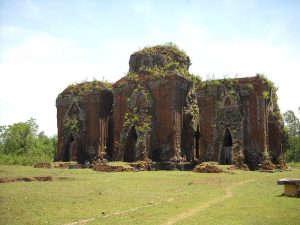
Binh Dinh
Binh Dinh is the second largest political and cultural center of the Champa dynasty. This is the place showcasing the mighty Champa, along with the pinnacle of Champa architecture and sculpture.
Silver Tower (Banh It tower), located in Nhon Hoa commune, An Nhon district, 18 km from Quy Nhon to the north, is a cluster of towers which was built in the 11th century on an extremely majestic high hill. Possessing the architectural art not only bears the imprint of ancient Champa culture but also has its own unique character of the martial land, the complex of Banh It tower relic is almost one of a kind and has great historical value.
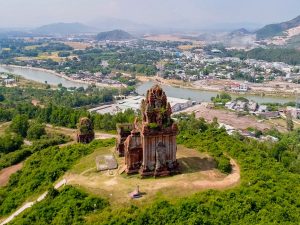
Besides, there are Hung Thanh twin towers in Quy Nhon city, also known as “one-of-a-kind” of Champa architectural art. The tower was built at the end of the XXII century and the beginning of the XXIII century, each corner of the tower was a statue of the god Garuda using two hands to support the roof of the tower.
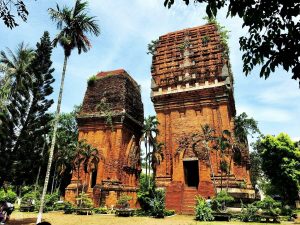
In addition, there are towers such as Binh Lam tower (Phuoc Hoa commune, Trung Phuoc district), Canh Tien tower (Nhon Hau village, An Nhon district), Thoc Loc tower (Nhon Thanh commune, An Nhon district), Thu Thien tower (Thu Thien commune, Tay Son district), Duong Long tower or Thap Nga (Binh An commune, Tay Son district).
Phu Yen
Nhan Tower National Monument is a unique destination in terms of architecture, art and beliefs. Nhan Tower is located on Nhan mountain, north bank of Da Rang river, Tuy Hoa town, Phu Yen province. The tower was built around the XXII century. During the resistance war, artillery shells made the top of the tower and 3 corners of the tower fell, then it was restored relatively completely to today’s shape.
The architecture of Nhan Tower consists of three parts according to the concept of the Cham people, namely: mundane, spiritual and divine, associated with the fairy tale of Ya Na. The tower is more than 20m high and 11m wide. From the tower, you can see the whole city of Tuy Hoa and the sea, rivers, fields, mountains…

Khanh Hoa
Ponagar Tower is the largest Champa architectural complex in Vietnam. Located on a hill about 2 km north of Nha Trang city center, the tower was built in the 11th century to worship the mother of Po Ino Nogar. The tower complex consists of 3 parts: Gate Tower, Mandapa (for pilgrims to rest, prepare offerings and dress before the official ceremony) and finally the temple area. But now there are only 5 works left due to the destruction of nature.
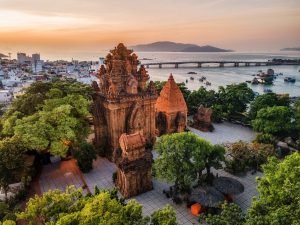
If you have a plan to visit Khanh Hoa this summer, please stop by Moonlight Apartment for shelter that will make you feel like home.
Ninh Thuận
Ninh Thuan is a place where many Cham people still live and it has a bold culture of the ancient Cham people from writing, ethnic costumes, sculpture, architecture, pottery and brocade weaving.
In Ninh Thuan, there is Hoa Lai Tower (Ba Thap) in Tan Hai commune, 14km from Phan Rang city which was built in the 8th century.
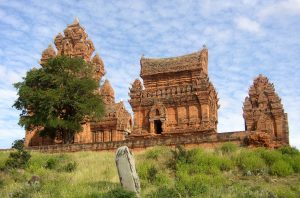
Along with that is the Po Klong Garai tower complex (Phan Rang city) which was built in the reign of King Jaya Simhavarman III, late XXIII – XXIV centuries. However, now only 3 brick towers remain: 9.35m high gate tower, 20.5m high Fire tower and the main tower worshiping King Po Klong Garai. This is considered one of the most beautiful towers of the Cham people, where the majestic Kate festival of the Cham people in Ninh Thuan takes place every year.

In addition, there is also Ppo Rome tower (Hau Sanh village, Ninh Phuoc district) which is located on a small hill, about 14km southwest of Phan Rang city. The tower was built in the 17th century – the last stage of Cham tower architectural art.
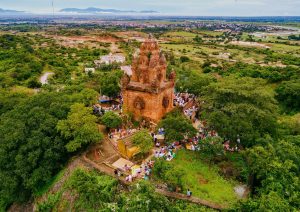
Binh Thuan
Phu Hai tower (Po Sah Inu tower) is the only Cham tower found in Binh Thuan. The tower was built very early, in the 8th century, in the Khmer architectural style.

Da Nang
If you adore Champa culture but have not had the opportunity to explore the Cham tower ruins. You can absolutely go to the Museum of Cham Sculpture to immerse yourself in the architecture, festival, costumes and remnants of relics displayed here. The museum is like a village of Cham people, which will make you feel calm and full of nostalgia about the ancient Champa kingdom.
